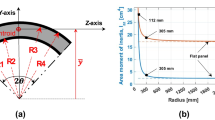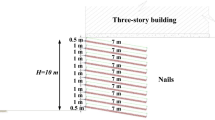Abstract
For years, coupled shear walls have been used in the mid-rise to-high-rise buildings as a part of lateral load resisting system, mostly because of their ability to control the displacement of structures. Recently, by changing the concept of design codes from strength-based to performance-based, assessment of nonlinear behavior of coupled walls became important for engineers. Therefore, many researchers now are looking for ways to improve and also predict the behavior of coupled walls under severe earthquakes. This paper presents the results of linear, nonlinear static (pushover), and nonlinear inelastic time-history analyses of a 10-story structure with two-dimensional coupled shear walls (CSW) which are perforated using three different patterns taken from considering the S22 stress of shell elements of shear walls. Nonlinear static analysis results confirm that perforation can increase the response modification factor of coupled walls up to 33 percent. In addition, the results of linear analysis and design indicate that perforation can reduce the required reinforcement of coupling beams and other frame’s structural components. In addition, results of nonlinear inelastic time-history analysis confirm that, using perforation patterns, the base shear—roof displacement hysteretic response improves and the systems with perforation patterns can absorb more energy under severe earthquakes.
























Similar content being viewed by others
References
Kim DK (2016) Seismic response analysis of reinforced concrete wall structure using macro model. Int J Concrete Struct Mater 10(1):99–112. doi:10.1007/s40069-016-0131-1
Hyun-Ki Ch (2016) Experimental study on shear wall with slab and opening. Int J Civil Eng, 1–21. doi:10.1007/s40999-016-0078-2
Marsono AK, Hatami S (2016) Analysis of Reinforced Concrete shear walls with single band of octagonal openings 20(5),1887–1894. doi:10.1007/s12205-015-0512-z
Paulay T, Santhakumar AR (1976) Ductile Behavior of coupled shear walls. J Struct Div ASCE 102(ST1):93–108
Galano L, Vignoli A (2001) Seismic behavior of short coupling beams with different reinforcement layouts. Author’s closure, ACI Struct J 98(5):788–788.
Harries K, Moulton J, Clemson R (2004) Parametric study of coupled wall behavior—implications for the design of coupling beams. J Struct Eng 130(3):480–488
CSI. ETABS (2015) Integrated building design software, nonlinear version 2015, Berkeley; (California), USA: Inc., 2015
Asghari A, Azimi B, Gandomi AH (2013) Effect of perforation on the hysteretic response of coupling shear walls. Int J Earthq Eng Hazard Mitig (IREHM) 1(1)
ACI. Building Code Requirements for Structural Concrete (ACI 318–11) and Commentary. 2011, American Concrete Institute, Farmington, IL
Federal Emergency Management Agency (FEMA). Pre standard and Commentary for the Seismic Rehabilitation of Buildings, FEMA 356, Washington, DC, November 2000
Newmark NM, Hall WJ (1973) Seismic Design Criteria for Nuclear Reactor Facilities, Rep. No. 46, Building Practices for Disaster Mitigation, National Bureau of Standards, U.S. Department of Commerce, 1973, pp 531–547
Miranda E, Bertero VV (1994) Evaluation of strength reduction factors for earthquake-resistant design. Earthq Spectra 10(2):357–379
Vamvatsikos D, Cornell CA (2002) Incremental dynamic analysis earthquake engineering and structural dynamics. Earthq Eng Struct Dyn 31:491–514
Author information
Authors and Affiliations
Corresponding author
Rights and permissions
About this article
Cite this article
Asghari, A., Azimi Zarnagh, B. A New Study of Seismic Behavior of Perforated Coupled Shear Walls. Int J Civ Eng 15, 775–789 (2017). https://doi.org/10.1007/s40999-017-0174-y
Received:
Revised:
Accepted:
Published:
Issue Date:
DOI: https://doi.org/10.1007/s40999-017-0174-y




